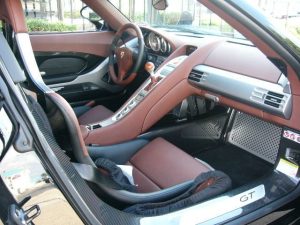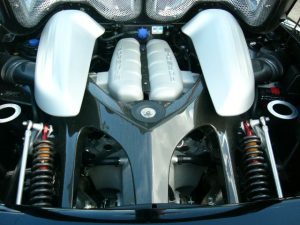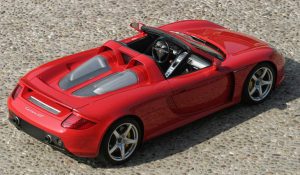
Introduction
The Porsche Carrera GT was originally conceived at the 24 Hours of Le Mans. As Porsche secured its sixteenth outright victory in June 1998, the idea was proposed of a road-going sports car based exclusively on racing technology. Two years later, in the autumn of 2000, that concept began to take shape.
As a pure encapsulation of Porsche engineering, the Carrera GT is a natural evolution based on more than 23,000 race victories. A road-going supercar built for uncompromising performance and unlimited driving pleasure.
That pleasure begins as you unlock the door with a squeeze of the key remote. Step inside and you’ll find an elegant composition of interior materials, including carbon fiber, leather and magnesium. Turn the key and the powerful V10 eagerly springs into life. The vigorous acoustics are an exhilarating prelude to what is an unforgettable driving experience. Blip the throttle, and the engine resonates with the rush of incoming air. The resulting sound is straight from the racetrack, only this time you can drive it on the road.
Power is delivered with explosive prowess, yielding equal measures of agility and precision with effortless energy and control. Acceleration through corners is accomplished with ease and barely a trace of body roll. The lightweight chassis combines with a low center of gravity and balanced weight distribution to achieve unprecedented cornering speeds.
With such uncompromising performance, the Carrera GT is a genuine racing machine. With its cultured refinement and all-round versatility, it’s a truly powerful presence on the road.
The Carrera GT is a totally new development based on Porsche racing design. As such, it carries all the familiar hallmarks of Porsche motorsport and our relentless passion for performance.
One of the most uncompromising vehicles ever created for the road, this latest generation of Porsche offers breathtaking performance in every respect. From a standing start, it reaches 124 mph (200 km/h) in just 9.9 seconds en route to a top track speed of more than 186 mph (300 km/h).
To achieve that performance, we’ve applied a powerful V10 engine – developing 605 hp (SAE) – to an unladen weight of just 3,042 lbs (1,380 kg).
Every last component in each area of the car has been custom-engineered for optimum performance. The result is a masterpiece of lightweight construction with an exceptional power-to-weight ratio. The main chassis structure is made from aerospace-grade composites, including carbon-fiber sandwich construction with a high-strength honeycomb core. These state-of-the-art materials combine major weight savings with intense structural rigidity to achieve exceptional performance and handling characteristics with exemplary safety reserves.
At the heart of the car, the mid-mounted V10 is mounted deep in the chassis to create an extremely low center of gravity. With less susceptibility to lateral g-forces, the car remains flat, consistent and inherently balanced through even the fastest racing bends.
By placing the engine and aluminium fuel tank directly behind the cockpit, it was possible to achieve a more even distribution of vehicle weight – one of the essential prerequisites for the car’s superior dynamics.
With such a total heritage in racing performance, there was only ever one layout option: an open-top two-seater with two-piece detachable hardtop.
Surrounded by so much power and agility, this classic configuration places you and your passenger at the heart of a truly exhilarating drive
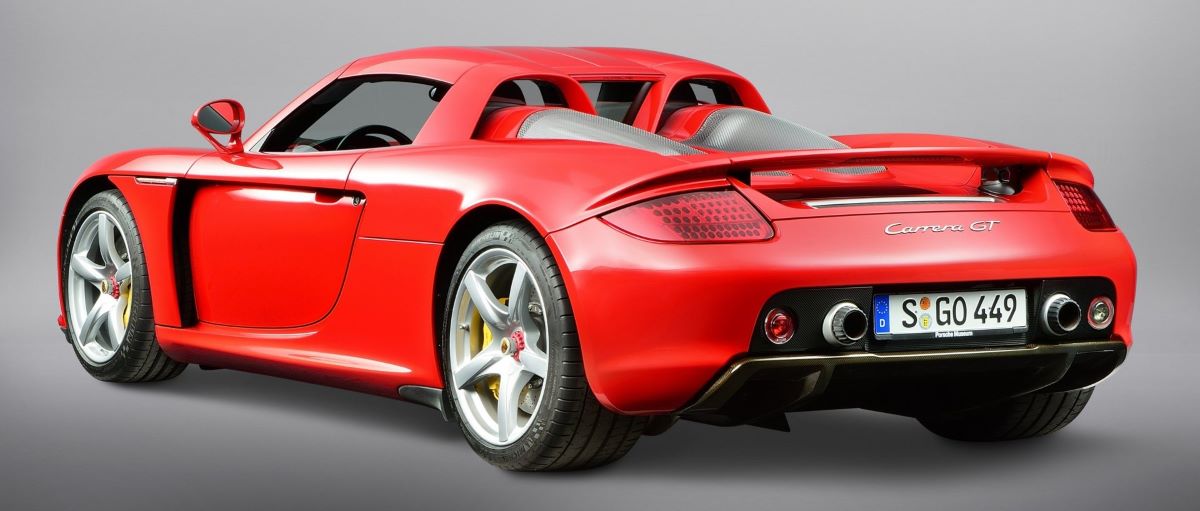
Engine
At the head of the engine, the twin-flow manifold system supplies a separate flow of air to each of the cylinder banks. To do that, the manifold is equipped with two separate throttle tracts as well as separate air filters with Helmholtz resonators. The resulting vibration of the incoming air is one of the key ingredients in the characteristic sound of the new Carrera GT.
This is another evocative reminder of the car’s genuine racing origins
For optimum performance in all load conditions, the engine is managed by twin Motronic ME7.1.1 control units, one for each of the two banks of cylinders. Specially adapted for the Carrera GT, the system incorporates a comprehensive range of management functions, including on-board diagnostics, electronic throttle, air-flow metering via hot-film air-mass sensor, and stereo lambda control. Key benefits of the twin-unit system include accurate implementation of all throttle inputs and, of course, consistent emissions control.
As a result, the Carrera GT complies not only with the stringent Euro 4 emissions standard, but also with the LEV regulations in the United States
One of the most important requirements of any racing engine is, of course, proper lubrication of all moving parts. On the Carrera GT, we’ve applied race engineering to achieve unparalleled performance in all road scenarios. Oil is circulated through a series of ten pumps, nine of which ‘scavenge’ the oil back from the engine. This ‘dry sump’ configuration ensures consistent lubrication, even under the extreme lateral loads possible in the Carrera GT. The external oil reservoir is incorporated into the gearbox casing, where it uses an integrated air separator to defoam the oil. A dedicated oil cooler is also provided to help limit engine temperatures.
Transmission
An engine as powerful as the new V10 in the Carrera GT demands an equally exceptional transmission.
In order to cope with the prodigious levels of power and torque, we’ve developed a new clutch technology never before featured on a standard production car: the Porsche Ceramic Composite Clutch (PCCC).
Essentially a two-plate dry clutch, PCCC™ offers unprecedented power density and a rotating mass approximately 10 times lighter than on a conventional clutch. The result is a more immediate throttle response and a reduction in synchromesh load. Pedal weight and travel are specially configured for a more intuitive and comfortable drive.
Inside the clutch, the hydraulically actuated plates are made from a ceramic composite material offering exceptional durability. Thanks to the modest plate diameter of 6.65 inches (169 mm), the system requires a much smaller clutch housing than conventional designs.
This in turn enables the crankshaft and drivetrain to be positioned much lower in the car, with obvious benefits in terms of driving dynamics.
Power is transmitted to the driven rear wheels through a racing-specification, six-speed manual gearbox followed by a multi-plate differential with locking under power and on overrun. Engine and gearbox are linked by a single-mass flywheel, which, thanks to its much lighter rotational mass compared with a dual-mass flywheel, adds to the immediacy of the throttle response.
The damping effect of a dual-mass flywheel – its primary advantage over a single-mass design – is cleverly replicated using a specially developed system of gearbox shafts. Operating on the same principle as a torsion spring, each shaft is fitted with a bevel gear system whose rotating mass helps dampen vibration in the driveline.
In order to achieve the lowest possible center of gravity close to the rear axle, the new six-speed gearbox is designed as an extremely compact unit with a transverse layout in the car. Key characteristics include precision gear selection, exceptional durability and a ratio spread configured for optimum acceleration.
The external transmission linkage provides a smooth gearshift action, while the twin push-pull cables help eliminate vibration and noise.
A perfect example of our integrated approach to race engineering, the new gearbox unit serves as a convenient location for the starter motor, differential and engine oil reservoir, as well as the PCCC ceramic clutch system.
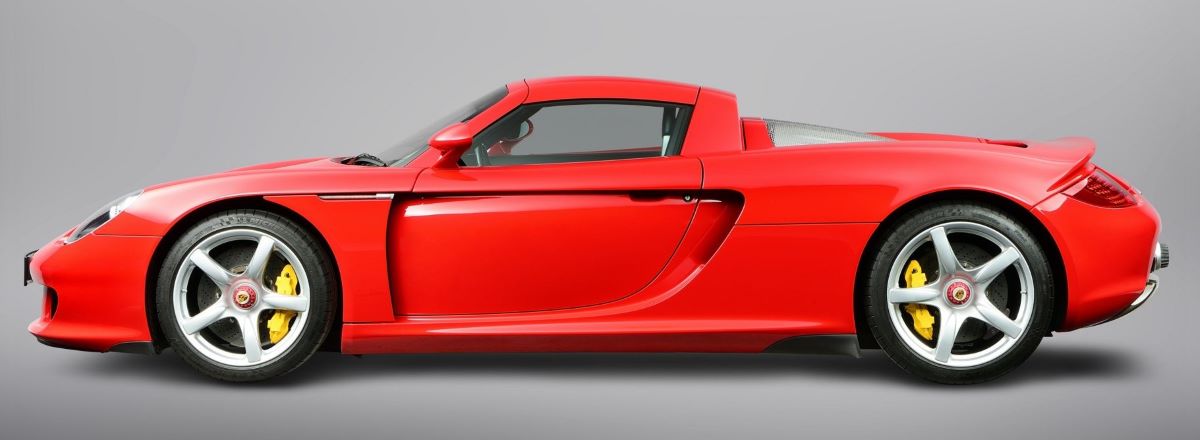
Running Gear
The steering system on the new Carrera GT is based on proven rack-and-pinion technology.
The steering gear is accommodated ahead of the main monocoque structure, where it is rigidly mounted to the bulkhead. Hydraulically assisted for a more comfortable drive, the system offers a direct response to driver inputs as well as detailed feedback from tires and road. A high-capacity pump supplies the requisite hydraulic pressure for even the most rapid steering inputs.
The safety steering column is also mounted directly on the monocoque to help dampen vibration and noise. Inside the cockpit, the three-spoke leather steering wheel features 1.57 inches (40 mm) of manual reach adjustment as well as a full-size airbag module
Step outside and the car’s uncompromising racing origins are powerfully reflected in the all-new five-spoke Carrera GT wheels. Measuring 19 inches at the front and a full 20 inches at the rear, these ultra-lightweight wheels are made from forged magnesium rather than more conventional aluminium alloy.
State-of-the-art technology in Formula One, forged magnesium represents a major step forward in reducing unsprung weight. By limiting wheel momentum as the suspension compresses and rebounds, it is possible to maintain greater contact between road and tire and thus maximize traction under acceleration, cornering and braking. Another important benefit is the added structural density – and therefore durability – that is imparted by the forging process.
The wheels are mounted using a center-lock system with a single multi-point nut. This race-derived solution is combined with a high-strength hub and large-format bearings to achieve a more accurate wheel location.
As on a racing car, the left-hand wheel nuts have a right-hand thread, while those on the right have a left-hand thread. This simple solution ensures that the thread on each nut runs contrary to the primary direction of travel on all four wheels. As a result, the rotation of each wheel tends to tighten the nut, rather than working it loose. For added security, each of the four nuts has a specially developed retention system. Grip is supplied in the form of high-speed Michelin tires with an extremely generous rolling circumference. Compound and tread are specially designed to ensure shorter braking distances and consistent handling, particularly in wet conditions. The tire dimensions reflect the performance of the car, measuring 265/35 ZR 19 at the front and 335/30 ZR 20 at the rear.
All four tires are equipped with an integrated tire-pressure monitoring system (TPMS) which issues an automated warning in the event of any drop in pressure. This practical solution can prove particularly valuable during high-speed racetrack use. If a deflation is detected, the puncture can be sealed using the on-board tire repair kit. Comprised of sealant, a compressor and a tire-pressure gauge, this compact kit helps to lighten the car by eliminating the need for a conventional spare wheel.
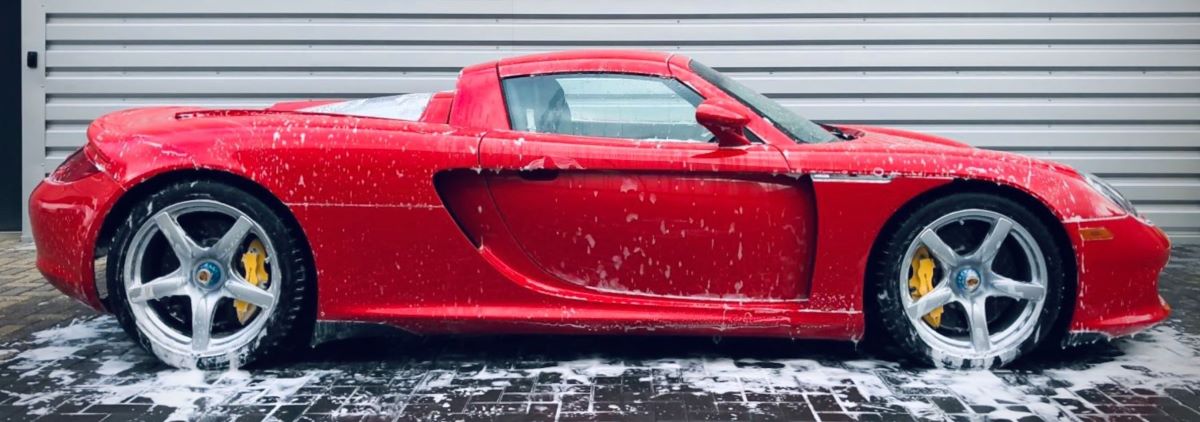
Design
The distinctive design of the Carrera GT presents race engineering in an elegant package that is uniquely and unmistakably Porsche.
With its imposing exterior and dominant rear wing, the car is instantly recognizable from every angle and a powerful presence on the road. At the front, the headlights pay sweeping homage to the legendary Porsche 917 – our first outright winner at Le Mans. Other distinctive features include the aerodynamically sculpted exterior mirrors and LED indicator modules.
Together, these elements combine past and present in a whole new application of Porsche design.
Among the more familiar Porsche features are the generous front inlets, the flowing wing contours and the very assertive angle of the nose.
The flanks are dominated by the prominent air outlets ahead of each door and the engine intakes to the rear. This elegant solution provides an adequate flow of air to the radiators in the nose, ensuring optimum cooling in all operating conditions.
At the rear of the car, the integrated wing is combined with an underbody diffuser featuring vertical fins. The resulting tail section generates ground-effects downforce with only minimal additional drag.
As you can see, the Carrera GT delivers form dictated by function. When that function is pure and rigorously pursued, the form is inevitably refined.
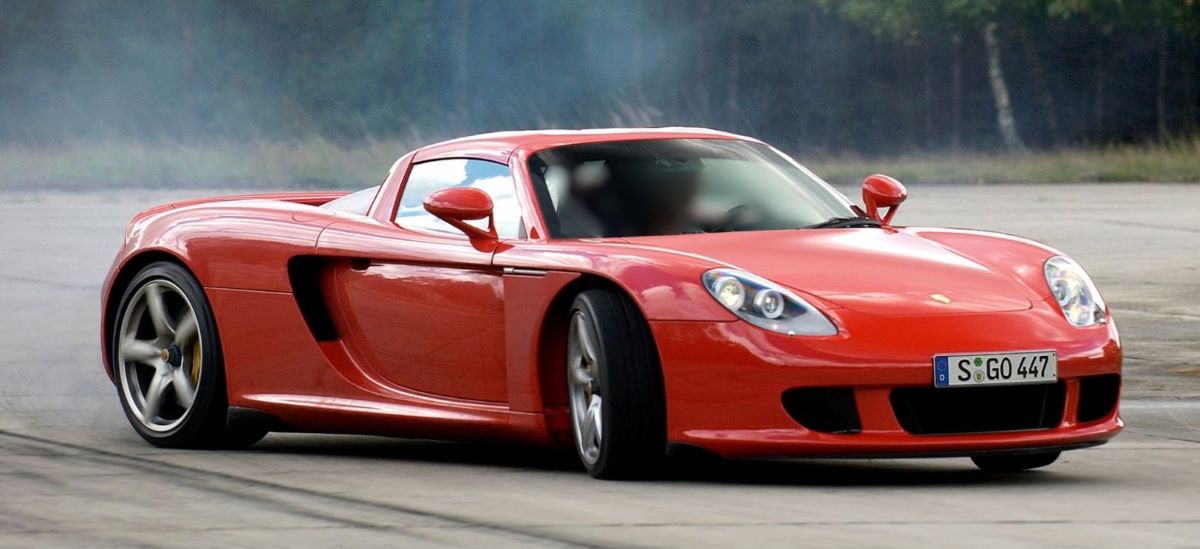
Chassis
The monocoque-based chassis on the new Carrera GT combines materials and know-how from the highest levels of international motorsport with the latest in aerospace technology.
The main chassis structure – monocoque, windscreen surround and supplemental safety system – is made from carbon-fiber composites with a honeycomb core. The technologies involved are state-of-the-art in Formula One and offer exceptional flexural and torsional strength.
To the rear of the monocoque is a highly robust yet lightweight carbon-fiber structure which supports the engine and gearbox unit. This structure – known as the engine carrier – is bolted to the monocoque with which it forms the main stressed members on the car. The resulting chassis is extremely light, yet considerably stronger than the pressed metal shell on a conventional car.
As the main structural members, the monocoque and engine carrier provide the mounting points for the suspension as well as the underlying structure for the external bodywork and cockpit assemblies. They are also designed to absorb impact energy in the event of a crash from the front and rear deformation zones. As the name implies, the engine carrier structure supports the entire powertrain assembly. Specially developed and patented by Porsche, this unique combination of monocoque and engine carrier offers a level of structural integrity that is not only exceptional on an open-top car, but also on a par with dedicated competition vehicles.
Like the majority of modern racing cars, the external bodywork on the Carrera GT is bolted to the underlying chassis structure. In contrast to a conventional road car, the external panels are completely unstressed and have a primarily aerodynamic and aesthetic function.
The race-car construction extends to the front and rear sections, which are bolted to the carbon-fiber chassis. The longitudinal layout of the engine, together with its low-slung position at the center of the car, creates a deep center of gravity to the rear of the cockpit. Generally regarded as the ideal configuration for racing use, this concentrated mass at the center of the car helps maximize control in all road situations, particularly in high-speed corners.
The fuel tank is also located directly behind the cockpit, where it consolidates the dynamics of the car. Apart from enhancing the overall balance, this race-proven layout prevents gradual changes in individual wheel loads as the fuel in the tank is consumed.
With these and other intelligent design solutions, the Carrera GT chassis provides the ideal platform for genuine supercar performance.
One of the most important principles of Porsche engineering is to improve on technology that already exists – and develop those that don’t. More often than not, this uncompromising approach gives rise to innovative new solutions. A perfect example is the lightweight chassis on the new Carrera GT.
The main chassis structures – monocoque and engine carrier – are produced as sophisticated sandwich constructions. Each component begins as a series of layers of ‘prepreg’ material – a reinforcing fabric made of carbon fiber impregnated with a curable resin matrix – which are laid up by hand in a mould. Depending on application, a central core of aluminium or plastic honeycomb is laid in the mould along with an adhesive film and then covered with a second prepreg skin.
This ‘sandwich’ of materials is then sealed in the mould and placed under vacuum in preparation for the ‘autoclave’ process. At this point, the mould is subjected to a specific set of temperature and pressure conditions to cure the composite structure. During this process, the resin matrix in the prepreg layers becomes polymerized and the adhesive film on either side of the core forms a solid bond with the skins. After cooling, the finished component can be safely removed from the mould.
To minimize weight, the prepreg material has an extremely low proportion of resin to carbon fiber. The choice of a unidirectional fiber, as well as its meticulous handling during the manufacturing process, ensures exceptionally high rigidity.
All materials used on both the monocoque structure and engine carrier are designed for long-term resistance to environmental influences. In the event of prolonged exposure to certain weather conditions – a combination of extreme heat and humidity, for example – the characteristic pattern of the carbon-fiber reinforcement may become partially visible through the painted exterior surface. Although extremely rare, this distinctive phenomenon serves to underline the authenticity of the carbon-fiber structure beneath.
In order to cope with the much higher temperatures encountered in the engine compartment, the material matrix on the carrier prepregs is formulated for added heat resistance. One of the more obvious characteristics of the carbon-fiber chassis can be heard when closing the doors. The distinctive sound provides a constant reminder of the pure race technology on the Carrera GT.
With its seemingly paradoxical mix of lightweight construction and heavyweight performance, the Carrera GT represents the pinnacle of chassis design. The result is a car that not only challenges convention, but also the laws of physics.
Safety
Fully compliant with some of the world’s most stringent safety regulations. Our own.
The power and agility of the new Carrera GT are second only to its exceptional standards of safety.
At Porsche, we believe that the most effective way to protect you and your car is to reduce the likelihood of an accident. To do that, we’ve developed an integrated philosophy of vehicle design to help eliminate body roll and aerodynamic lift, while enhancing mid-corner grip. Precision steering is combined with exceptional stability and one of the most powerful braking systems ever featured as standard on a production car.
In the unlikely event of an accident being unavoidable, the Carrera GT offers a comprehensive system of occupant protection, including longitudinal members at front and rear made from high-tensile stainless steel. This highly effective deformation structure uses optimized geometry and specially profiled elements to help channel impact energy in a safe and carefully controlled manner.
If the vehicle overturns, the cockpit is surrounded by a system of high-tensile steel elements in the windscreen frame as well as an extremely robust composite roll structure located directly behind each seat. High-strength tubular steel elements in each of the doors provide additional passive safety with predefined energy dispersal.
In addition to the exceptional stiffness of the chassis structure, the front and rear deformation zones and the frameless composite doors, the Carrera GT comes with a full range of standard safety features including full-size front airbags and
a side-impact protection system comprised of side airbags and energy-absorbent panels.
Each occupant is safely secured using a three-point seat belt featuring pyrotechnic pre-tensioners and force limiters.
For optimum safety when driving at night, the Carrera GT comes with the latest Bi-xenon headlight technology and an integrated headlight cleaning system. Each headlight module is equipped with a powerful xenon bulb, which generates approximately three times as much light as conventional halogen systems while offering a much longer service life.
To ensure the safety of the car itself, we’ve included a comprehensive anti-theft protection system, including full Porsche alarm with infrared interior surveillance and an electronic engine immobilizer.
For added security under braking and acceleration, the Carrera GT is equipped with a combined anti-lock braking and traction control system (ABS/ASR 5.7), including engine drag torque control, offering optimum assistance in varying all weather conditions. The traction control or ‘anti-slip regulation’ system (ASR) provides direct coordination of all four wheels to smooth out any variances in traction. This selective regulation of each individual wheel enables the car to maximize the available grip and achieve balanced acceleration and braking. For added driver involvement, the traction control system can be manually disabled at the wheel.

Comfort
The Carrera GT is instantly recognizable as the epitome of Porsche engineering. Not only when you approach it for the very first time, but also when you open the door. As you step across the logo on the door entry guard, you’ll discover a new and elegantly integrated cockpit with a blend of simplicity and high-tech refinement. A harmony of line and pure functionality that reflects the race origins of the car.
To minimize weight, the cockpit is free of all extraneous detail. Despite its obvious links with the more minimalist aesthetics of race-car design, the Carrera GT offers exceptional interior comfort. Elegantly crafted from a palette of exclusive materials, the distinctive interior includes a number of race-bred features. One of the most important is the carbon-fiber monocoque, which is partially visible in some areas of the cockpit, and embellished with a leather or paint finish in others. Other key features include a range of details in lightweight magnesium or aluminium.
As you take your place behind the wheel, you’ll find an ergonomically designed cockpit in which all information sources and driving controls are easily accessible at all times.
The hierarchical layout enables optimum focus on the road ahead and thus maximum driving pleasure.
The rest of the cockpit is sculpted around the driver to create a more intuitive connection with the car. The distinctive center console, for example, arches up from the floor to the center of the dashboard to place the short throw gearshift within easy reach of the steering wheel. The carbon-fiber console structure, with its deep-drawn magnesium trim, provides added stiffness to the chassis structure for even better handling and safety.
All information is clearly presented in a classic Porsche instrument cluster. The information display in the lower half of the central tachometer provides a useful overview of all key data. Featuring dot-matrix technology for an extremely high resolution, the display can be used to view the total mileage and trip odometer as well as a range of driver-selectable data from the on-board computer. The green tinted windscreen is made from laminated safety glass and offers exceptional forward visibility. The windows in each door are also tinted and made from single-sheet safety glass with a hydrophobic coating. This simple solution helps accelerate the dispersal of water from the surface of the glass to provide an unrestricted view of the exterior mirrors. The rear screen is divided into three separate sections and made of lightweight polycarbonate.
The lightweight seats combine elegant leather upholstery with a single-piece carbon fiber and Kevlar shell. Both are available in a choice of two widths with optimum lateral support and manual fore/aft adjustment.
Clearly inspired by the car’s racing specification, the Carrera GT interior offers a subtle combination of comfort and elegance that is ideally suited to everyday road use.
The Carrera GT represents a major milestone in the development of road-going technology. Not only throughout the engine and chassis, but also in the passenger compartment.
Among the no-cost options available on the car is a highly sophisticated navigation and audio system. As well as guiding you safely to your destination, this versatile new system provides a powerful accompaniment to the V10 engine in the form of an integrated BOSE® Sound System. Like the Carrera GT, this high-end audio platform combines lightweight construction with uncompromising technology to achieve exceptional all-round performance. One of the most striking features of the system is the powerful bass output from the 25-liter enclosures in each of the door-sill sections.
Sound is delivered through a pair of 100-Watt amps and six high-performance speakers. This two-channel system uses a range of BOSE technologies, including Active Equalization, to create a virtual panorama of lifelike sound that’s custom-engineered to the car.
The passenger compartment features an elegant arrangement of high-tech materials, ranging from lightweight magnesium on the door release handles and center console trim, to aluminium pedals in the footwell. The dashboard is moulded in genuine carbon fiber with a cool titanium paint finish.
At the head of the center console is an aluminium gearshift with natural wood inlay in homage to the 917. The first racing Porsche to claim outright victory at Le Mans, the 917 received a balsa-wood gearknob as a last-minute measure aimed at further reducing the weight of the car. On the Carrera GT, the gearshift is located within easy reach of the three-spoke leather steering wheel, which features a full-color Porsche Crest plus 40 mm of manual reach adjustment.
Despite its pure racing origins, the Carrera GT has all the subtle refinements you’d expect of a Porsche. From electric windows with one-touch operation and door seal protection to remote central locking, power release lids, and electrically adjustable mirrors with internal heating and aspheric glass on the driver’s side. Other standard equipment includes driver and passenger sun visors and a lockable glove compartment.
The luggage compartment is located at the front of the car and comes with a tailored travel bag as standard equipment along with a garment bag, briefcase, shoulder bag and center console bag. Each of these accessories is finished in genuine Porsche leather matched to the interior of your car.
For added comfort, the Carrera GT is available with automatic air conditioning as another no-cost option. Standard equipment includes a heating and ventilation system with steplessly adjustable blower, interior filter and recirculation control. A particle and pollen filter are also included to ensure optimum air quality at all times.
As on all Porsche racing cars, the ignition is located to the left of the steering wheel for easier access on entering the car. Turn the key and you’ll experience a level of performance that exceeds all expectations. Squeeze the throttle and you can finally appreciate the quality of the interior and the purpose for which it is intended.
Environment
One of the most effective means of protecting natural resources is to create quality products that last. At Porsche, that’s a principle we’ve consistently applied throughout more than 50 years of production.
On the Carrera GT, we’ve combined the obvious objectives of performance, practicality and vehicle safety with a comprehensive range of environmental considerations, including fuel economy, maintenance and durability.
Exhaust emissions have been reduced to a minimum through a combination of advanced engine technology, on-board diagnostics (OBD) and, of course, a dual exhaust system with catalytic converters and stereo lambda control. The on-board diagnostics system provides continuous monitoring of engine and exhaust, issuing a warning to the driver via the instrument panel if a fault is detected on board.
As a result, the car offers full compliance with the stringent Euro 4 standard as well as LEV regulations in the United States. Noise emissions are eliminated at source – without the need for engine encapsulation. The resulting sound complies with all existing noise legislation while delivering the distinctive acoustics of a thoroughbred Porsche.
All materials have been carefully selected for optimum environmental compatibility. As a result, the car is totally free of asbestos, cadmium and CFCs, as well as components manufactured using CFCs.
This considered approach to natural resources is reflected in the service intervals: engine oil and air filter every 12,000 miles (20,000 km), oil filter every 24,000 miles (40,000 km) and spark plugs every 24,000 miles (40,000 km) or four years. Most remarkably of all, the original fuel filter and engine coolant never need replacing at all.
Finally, we come to one of the most important factors as regards the environmental compatibility of your Porsche: its exceptional durability. This legendary quality is confirmed by the fact that approximately two out of every three cars we’ve ever built are still on the road today.
Porsche Carrera GT Specifications

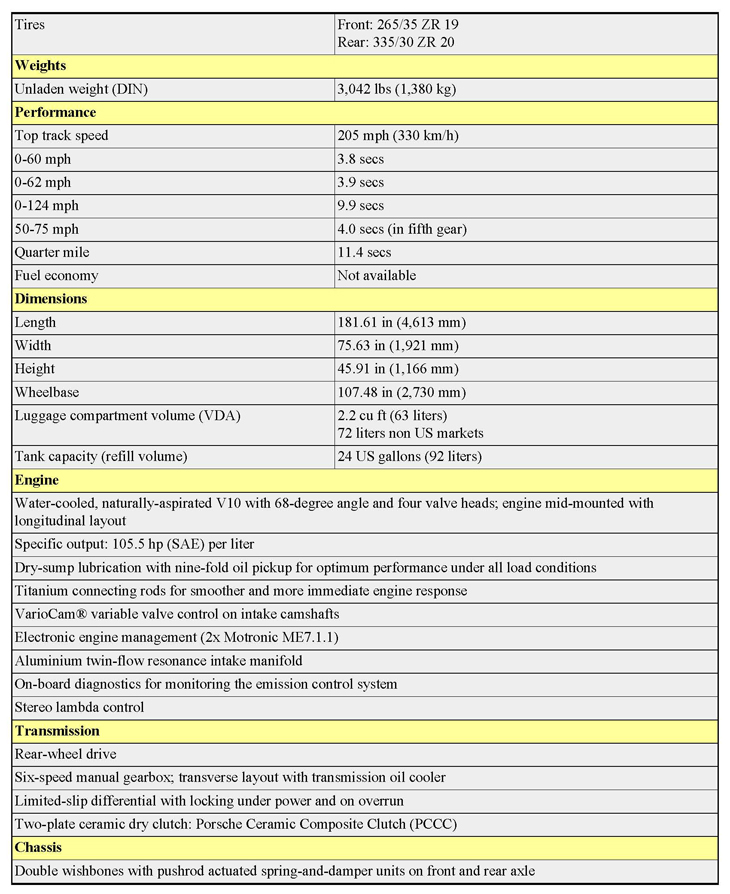
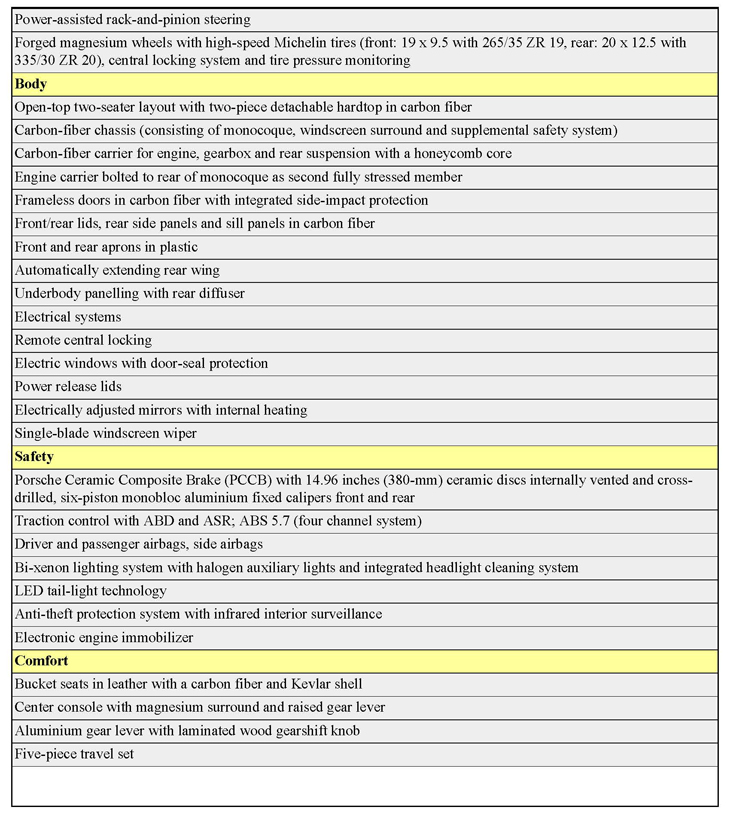
Porsche To Build Carrera GT Sports Cars in Leipzig, Germany
Company Plans to Produce Approximately 1,000 Units at the New Porsche Cayenne Assembly Plant. Carrera GT Engines to be Built in Zuffenhausen, Germany.
ATLANTA, JULY 9, 2002 — Dr. Ing. h.c. F. Porsche AG announced that it will build approximately 1,000 Carrera GT high-performance sports cars at the company’s new production facility in Leipzig, Germany. This news comes just six months after Porsche’s Board of Management revealed at the North American International Auto Show in Detroit that it would indeed produce the V10-powered supercar, which will be introduced in the second half of 2003.
While the Carrera GT will be built at Porsche Leipzig, also the production site for the 2003 Porsche Cayenne sport utility vehicle, the sports car’s new naturally aspirated V10 engines will be manufactured – like all Porsche engines – at the company’s historic facility in Stuttgart-Zuffenhausen, Germany. In addition to the production facility, Porsche Leipzig also features a paved track suitable for testing Carrera GT and Cayenne vehicles and the Customer Service Centre where new Carrera GT and Cayenne owners can take delivery of their new vehicles.
“With the Carrera GT, we hope to consolidate further both our expertise and our leading position in the sports car segment,” said Dr. Wendelin Wiedeking, Porsche AG CEO and chairman of the Porsche Board of Management. “The decision to have Stuttgart supply the power unit emphasizes not only our appreciation of the original plant, but also our philosophy that the heart of a Porsche sports car – the engine – comes from Zuffenhausen. This is also why we invested EUR 50 million in a new engine factory this past November.”
Porsche’s announcement creates approximately 70 new jobs at the Leipzig facility, and 25 jobs at Zuffenhausen. Porsche Leipzig can be found on the Internet at porsche-leipzig.com
Porsche first unveiled the Carrera GT during a pre-dawn ceremony at the 2000 Paris Automobile Salon. The two-seater sports car is based on pure racing technology. The chassis, made mainly from carbon fiber, ensures high rigidity, passenger safety and low weight. The six-liter V10 engine is estimated to produce 558 horsepower (DIN) and 330 lbs./ft. of torque. Combined with a six-speed manual transmission, the Carrera GT will have an estimated top speed over 205 mph (330 km/h).
NEWLY DEVELOPED TIRES FOR THE PORSCHE CARRERA GT
16/08/2013 | Porsche Cars
Michelin Pilot Super Sport tires with Porsche-specific “N0” designation
Atlanta. Dr. Ing. h.c. F. Porsche AG, based in Stuttgart, has developed a new tire for the Carrera GT in partnership with tire manufacturer Michelin. The new tire once again noticeably enhances the handling of the 1,270 versions of the super sports car built between 2003 and 2006. The new Michelin Pilot Super Sport tire, which now replaces the current Pilot Sport PS2 tire on the Carrera GT, brings together the findings of ten years’ worth of tire development to give drivers of the Carrera GT noticeably improved handling, even faster lap times and a more harmonious driving experience overall.
Drivers will even see benefits in relation to the stability of the Porsche model at its top speed of 330 km/h, as well as its behavior at high lateral acceleration speeds. This is all down to the new structure of the tire, which, of course, features the Porsche specification “N0” on the sidewalls. The tread compound of the Pilot Super Sport tire, which is manufactured on the same production line as Michelin racing tires, is based on “dual-compound” technology. With this technology, different rubber compounds are used for the inside and outside of the tread. This concept offers maximum grip on bends and highly precise steering behavior. What’s more, the belt is made from an especially durable mix of aramid fibers, which are five times lighter than steel but deliver the same tensile strength. In addition, the variable contact area distributes the pressure evenly across the tire, meaning as much of the tread as possible is always in contact with the asphalt under any driving conditions.
The new Carrera GT tires are available now in 265/35 ZR 19 98Y “N0” and 335/30 ZR 20 108Y “N0” dimensions. Alongside optimized performance criteria, these tires offer the cost-effective side-effect of increased mileage: Compared to the previous tire, mileage is up to 10% higher on normal roads, and even as much as 20% higher when the tires are used on tough race tracks. The new tire also improves braking performance, showing that, even after ten years, Porsche is still working just as hard to look after drivers of its older models as it does to look after drivers of its new vehicles.




